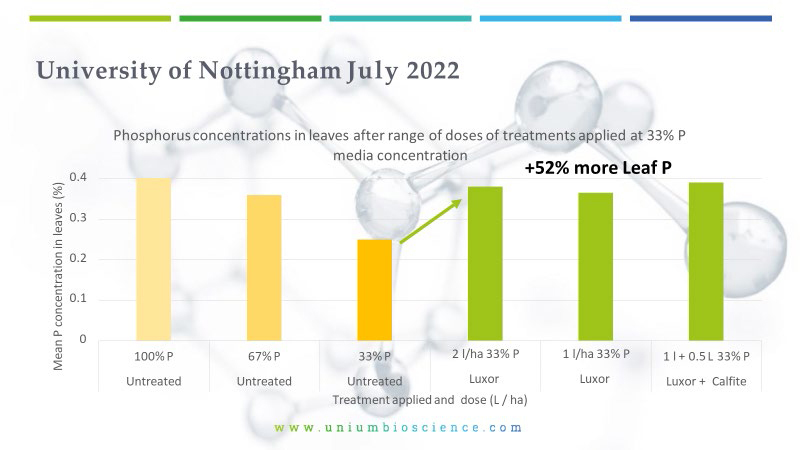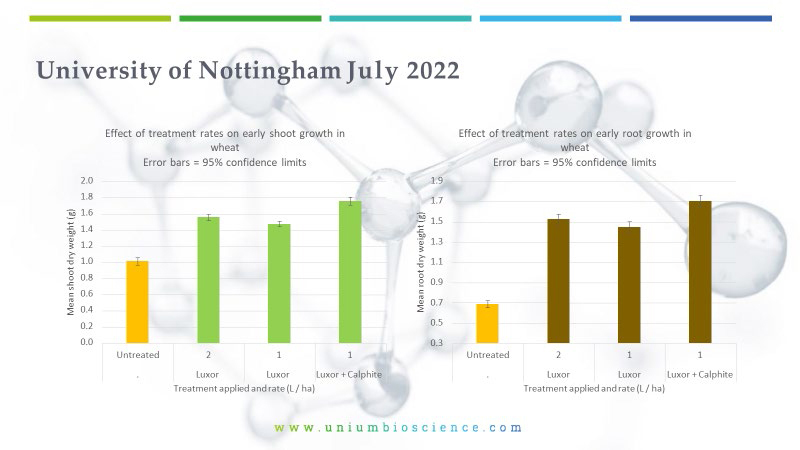Setting up wheat crops for spring growth
Ensuring wheat crops can make the best use of nutrients this spring will be critical in the run up to T0, especially in a season when many growers have taken a fertiliser holiday and where plant rooting may have been compromised.
The latest bioscience technology from Agrovista offers cost-effective solutions to help wheat (and other crops) access nutrients. We asked company agronomists around the country what they will be recommending over the next few weeks.
Somerset, Wiltshire, North Dorset
Peter Waltham incorporates bioscience products into seasonal agronomy programmes but as with all inputs he avoids being too prescriptive.
“The choices we make go hand in hand with tissue testing and the need for general micronutrient products and we will base our final decisions accordingly,” says Peter.
During March ahead of T0 he will consider foliar applications of Calfite Extra and/or Luxor (see box) to improve phosphate levels in wheat, particularly where the farmer has taken a fertiliser holiday or where availability is poor, for example on calcareous or acid soils or where indices are low.
“Phosphorus promotes early root growth and winter hardiness and stimulates tillering,” says Peter. “But it is easily bound up as insoluble phosphate compounds. Both these products offer a really good way of dealing with this.”
At T0 he favours Terra-Sorb Foliar Extra at T0 along with L-CBF Boost to lift brix levels and helps plants perform closer to their optimum.
L-CBF Boost is becoming a routine inclusion in Peter’s recommendations. “Microbe levels have declined over the years as arable farming has intensified,” he explains.
“Increasing their numbers will help improve nutrient cycling and increase the productivity of applied fertilisers.”


Midlands
Making the most efficient use of nitrogen has taken on a new importance given the volatile nature of fertiliser markets, says Dan.
Heathy, extensive root systems are the key to this and nutrient use efficiency in general, so he will use Calfite Extra as a base and add Luxor where phosphorus supply is limited or rooting compromised in the run up to T0.
“I recommend them from the onset of spring growth once the crop has reached tillering. Get them on early and you get more bang for your buck.”
But Dan is also recommending a novel biostimulant product called Twoxo XL on crops with good potential where nitrogen may be limited, for example where the total amount of nitrogen needs to be reduced to meet on-farm stock levels, where a high purchase price has been paid or to reduce carbon footprint.
“Twoxo plays a vital role in the nitrogen and carbon pathways and therefore improves Nitrogen Use Efficiency (NUE),” says Dan.
“I’ll use it from T0 and up to GS 31, around the timing of the main fertiliser applications, so the plant can make better use of what is there, enhancing photosynthesis in the plant and increasing biomass and yield.”
Cumbria/Durham
Steven will often use Luxor in spring when applying manganese to get winter wheat off to a good start.
“It is a pretty low-cost option where phosphorus is the limiting factor,” says Steven. “Luxor can replace bagged phosphorus fertiliser in cereals and in oilseed rape allows us to reduce the rate of DAP with OSR at drilling.”
He prefers Calfite Extra on winter barley. ”Barley yield is heavily influenced by tiller/ear numbers, so we need to promote good crop growth and healthy tillers as early as we can.”
Steven also uses other products such as Terra-Sorb Foliar Extra, a blend of 21 plant-based amino acids and trace elements, and Equilibrium Extra, which combines the same amino acids with seaweed extract, to relieve stress on a variety of crops.
“Amino acids provide a quick boost to a stressed plant that has limited ability to function, whether due to moisture, nutrient, soil or pest and disease factors.”
Bioscience products are making a real difference when it comes to nutrient use efficiency, helping crops, the environment and the bottom line, he adds. “There is no doubt that farm average yields are going up where we are using them.”


Sussex, Surrey and Kent
L-CBF Boost proved a great success for one of Linda’s customers last year, resulting in a significant saving in inorganic nitrogen fertiliser.
“Soil health results revealed that there were high C:N ratios, low respiration and very low potentially mineralizable N,” says Linda. “The grower had applied 12-month-old FYM which had been mixed with horse bedding containing wood chip, so nutrients were not readily available.”
The soils were likely to be fungal dominant rather than a balance of fungi and bacteria. L-CBF Boost applications were aimed to ‘wake up' the soil microbiology, help balance soils and utilise the organic material present already in the soil.
Given the high price of nitrogen fertiliser, the grower said he was not going to buy any more, despite being at least 20% short, according to RB209 recommendations, Linda explains.
“I advised the use of L-CBF Boost on wheat, barley and rye to feed the soil microbes. We didn’t apply the full RB209-recommended rates of nitrogen on any of these crops, yet they produced some fabulous yields.
“Needless to say, the grower was delighted and is adopting the same policy this year, using 10 litres/ha of L-CBF Boost both in the autumn and spring followed by smaller doses of 3-5 litres/ha thereafter with plant protection products.”
Linda is also advising growers on calcium-dominated soils, or those taking a fertiliser holiday, to consider using Calfite Extra and Luxor on cereals during tillering to promote rooting and maintain plant phosphate levels and enhance nitrogen use efficiency.
She will also consider Wholly K PGA at T1 to supply potash for those farmers taking a fertiliser holiday, and to further enhance NUE.
Product profiles
Calfite Extra contains calcium phosphite, which tricks the plant into reacting as if it were deficient in phosphorus, stimulating root and biomass growth. It also contains L-PGA (pidolic acid) to increase nitrogen assimilation within the plant.
Luxor contains foliar phosphorus, humic and fulvic acids to stimulate soil biology to maximise nutrient availability, and L-PGA.
Terra-Sorb Foliar Extra is a blend of 21 readily available amino acids and trace elements, helping plants make better use of existing resources.
L-CBF Boost is a filtered molasses product that contains range of nutrients that increase soil microbe levels, improving plant nutrient availability.
Twoxo XL contains 2-oxoglutaramate, which stimulates plants to increase carbon dioxide uptake and seek out and assimilate more nitrogen.
Wholly K PGA delivers potassium via foliar application when conditions may limit soil uptake. It contains L-PGA.
Nottingham University trials
Work at the University of Nottingham clearly shows that Luxor + Calfite Extra matches or exceeds the performance of even soil applied P – for much lower cost.
Luxor delivers more P to the plant than products containing more phosphate.

Additional benefits of Luxor + Calfite tank-mix

Apply Luxor PGA1.0 l/ha + Calfite Extra 0.5 l/ha any time between beginning of spring growth and GS 30 (can be used in tank-mix eg with micronutrients) on winter cereals and typically early post-emergence on spring crops (eg GS 13- 23 on spring cereals).